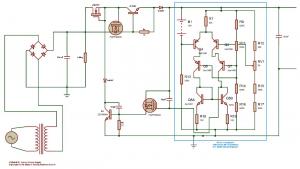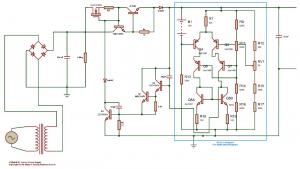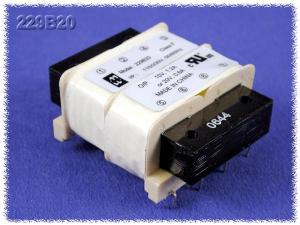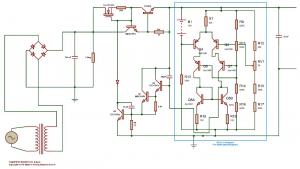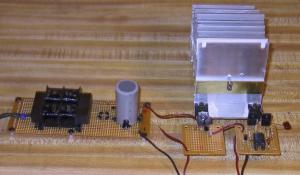-
Posts
44 -
Joined
-
Last visited
Profile Information
-
Gender
Male
Converted
-
Location
Asheville, NC, USA
-
Occupation
IC Design Engineer
-
Hobbies
Electronics, Audio, Music, Photography
-
Headphones
Stax Lambda, AKG K240, Yuin Pk1
-
Headphone Amps
Stax SRA14S, Custom Amps
-
Sources
Thorens & Stax CP-Y, Wadia 861 & 170i
-
Other Audio Gear
Custom speakers and Amps
Recent Profile Visitors
The recent visitors block is disabled and is not being shown to other users.
Linear's Achievements

Advanced Member (3/6)
0
Reputation
-
This project looks very interesting. The two KGs have certainly done some great work! I may have missed some earlier threads on this, but from what I have read, you plan to offer this a DIY kit, correct? If so, will purchase info be posted on this thread? Keep up the good work, Gentlemen. Best regards, Linear (Doug
-
Thanks Kevin. Very interesting! Similar?.....Well they both use HV opamps, probably both with a lot of global feedback around them. Birgir, if you could post photos, that would be great. Best regards, Doug (aka Linear)
-
Does anyone know if the Stax SRM-D10 and the Shure KSE1500 / KSE1200 use similar amplifier circuitry? I read somewhere that the SRM-D10 uses an Apex Microtechnology HV opamp. Perhaps this is also the case with the Shure units? As Manueljenkin mentions above, there seems to be very little technical info available on the Shure amps and as well, the Stax D10. An info would be very interesting and much appreciated!
-

Discussion on the design of the T2 & other circuitry
Linear replied to kevin gilmore's topic in Do It Yourself
Time for an update on the "kgdwhps3" schematic shown in the previous post (#91). My MOSFETS finally arrived, and I got it on the bench..... Bottom line: It is VERY difficult to make stable with the MOSFET output on the active battery. Using the FET increases the gain of the circuit dramatically, and this is a problem. I cut the gain down by adding a resistor (51K) across the gate and source of the fqpf8N80c, but it still takes lots of capacitance to tame it. So, right now the MOSFET version is a work in progress. MEANWHILE, the bipolar version "kgdwhps2" (post #90) seems to work perfectly, with only 50 pF compensation caps. I've taken it up to 50 mA with 50 uF on the output and it's fine. I haven't measured any noise yet because my "Plexiglas blast shields, Teflon caps, and 5 digit floating noise analyzer" are still on back order! (as recommended by KG for diode noise measurements. ) Regarding the DWSR block that I re-designed, I will have more information very soon. Linear -
I'm just about to undertake this exact task. Could you share some of your trickery?
-

Discussion on the design of the T2 & other circuitry
Linear replied to kevin gilmore's topic in Do It Yourself
Attached is "kgdwhps3". I haven't tested this yet, but if it can be made stable, I think it would be the best topology for the new Hybrid PS. (I'll get it on the bench as soon as my fqpf8n80c's arrive from Mouser.) Compared to version 2, the HV NPNs are gone, replaced by the MOSFETs. The ixys10m90s is gone, replaced by the Supertex LND150 (available at Mouser). This is a TO-92 device, off the heatsink. Only the isolated package MOSFETS are on the heatsink, making this easy to build. For higher power and voltage (I'm testing these ideas at 250V @ 50mA), we might add more '8n80c's in parallel, and more LND150's to share to load. Thanks to luvdunhill and the Basaudio guys for suggesting the LND150 (only $0.69!). It's a handy little HV current source. Check it out. Linear Update: Has been tested and has stability problems. See next (#92) post. -

Discussion on the design of the T2 & other circuitry
Linear replied to kevin gilmore's topic in Do It Yourself
"Bug Fix" on the ".kgdwhps1". Latest version attached: "kgdwhps2" Added diode in series with series element to avoid reverse current through 2n3904 and Rs. There may (actually, probably will) be additional "fixes". So, don't generate your BOMs just yet! This means you, Justin! (By the way, I really like your chassis work.) Linear -

Discussion on the design of the T2 & other circuitry
Linear replied to kevin gilmore's topic in Do It Yourself
Yes, the Hammond 229 series is a split bobbin. (They call it a "semi-toroid" because it has a few characteristics in common with toroids.) I want to compare the 229 against true toroids, which would have better regulation, lower self-magnetizing current, etc..... In other words, are true toroids that much better that we can rule out using the 299 series? -

Discussion on the design of the T2 & other circuitry
Linear replied to kevin gilmore's topic in Do It Yourself
Think I'm going to build a pure shunt PS for my T2 (the one that isn't built yet!) This "kgdwhps" seems to be working really well and the heatsinks really "eat the heat". For transformers, why not use 10 Hammond 229B230's, a 229B56 to get 60V for the 560V rail, and a 229B24 for the +/- 12V. Make it modular, using 12 identical PCBs. The PCB layout could take any of the 229 Series transformers and could then be stuffed to create any voltage. (Triad also second source the 229 Series, as their FP line.) As I said before, this would really spread the heat generated by the transformers around the PS chassis. So what's wrong with using these "semi-toroids"? Let's hear all the advantages of using toriods. Check out what you get for $12 in the pic below. -

Discussion on the design of the T2 & other circuitry
Linear replied to kevin gilmore's topic in Do It Yourself
Well, there has been a lot of “talking” on this thread, but not too much bench testing of the ideas. I think that KG is the only one to help out in that area. So, I decided to do my share. I’ve built a breadboard of what I egotistically call the kgdwhps1, and I think that I have some interesting results. The circuit incorporates KG’s hybrid idea (post #19), and my series element (post#24 on the left), but with a bipolar pass device with an ixys FET current source driving its base. (I suggested this exact configuration as “dwpass6” to KG in an email on March 31.) This pass element only has the isolated package MD2310FX on the heatsink Also, I’m using a re-designed version of the “active battery” section (in the blue box) that I call “dwsr”. It doesn’t use any HV transistors (more details on the dwsr later). See the attached schematic. I’ve also attached a photo of my bench setup. This thing is designed to deliver 250V @ 50 mA. It can run as a shunt, hybrid, or series PS, just by changing the values of Rs, and Rh. I’m using a Hammond 229B230 “semi-toroidal” 12VA EI type transformer. These are widely available and only cost about $12. It would take 10 of them to build a full T2 supply, and they could be mounted on the PCB, thereby spreading the transformer heat around. I know they exhibit poor load regulation (20%), but the regulator can handle that. Tell me again why I should order custom toroids? Unfortunately, my ixys diodes are on order. I thought I had some 1n4937 (200ns) diodes around here somewhere, but I can’t find them. So, I’m using “double O seven’s”. I’m not sure how bad (or good) the initial switching noise is with this arrangement (compared to DSEP12-12B’s and a toroid). Comments are welcome (see posts #82, 83, and 84). RESULTS It works! I had to put 50 pF caps across the CB junctions of Q2, and Q1/Q3, to stabilize and set a dominant pole for the two feedback loops. Once that was done, I tried it with no load, dead short circuit (47 mA) and with a 25 mA load. All OK. Hybrid mode also works fine. Obviously, I need to do much more testing, and probably add a couple of zeners for protection. Could try MOSFETS (eg fqpf8n80c), which would hopefully be stable. Looks like a TL431 (Basaudio style) in the series element is NOT stable with the dual feedback loops (KG’s tested it). I’m probably wasting my time testing noise until I get my ixys diodes, right? HEATSINK I have been looking at the heatsink issue for a while (see DIY T2 Clone thread), and so I decided to try a piece (3” long) of the “super large” one I have. It’s cross-section is 4” x 5” with 19 fins! You can see it in the photo. I ran “kgdwhps1” in shunt mode, pumping 11.2 W into it. The ambient was 74 F, and that 3” piece of heatsink stabilized at 114 F. That means an 18” length could handle 67.2 WATTS! That’s just ONE side of a T2 type chassis, so it’s 134 W for a full chassis. KG, your 150 watt chassis is reality! Stay tuned. More to come. Linear -

Discussion on the design of the T2 & other circuitry
Linear replied to kevin gilmore's topic in Do It Yourself
Just to clarify. (I'm a bit foggy today, I guess!) If we built a PS with and EI style transformer connected to a 1n4007 bridge, would it have lower switching noise that a torroid /ultra fast diode setup? (Assuming the same capacitor values, etc) -

Discussion on the design of the T2 & other circuitry
Linear replied to kevin gilmore's topic in Do It Yourself
Could you give us a quick (few lines) primer on the trade-offs with diodes and transformers? EI transformers? Are they the standard ones with the E shaped laminated core? Are they better for noise? Why use toroids then? Because of their better regulation and lower losses? What about diodes? Anything special about the DSEP12-12B? Will any fast recovery diode work as well? How do "lousy diodes" help with noise? Should we all be using lousy diodes and EI transformers to minimize noise? I'm confused and need advice from the Doctor! I hope that the Doctor is in! -

Discussion on the design of the T2 & other circuitry
Linear replied to kevin gilmore's topic in Do It Yourself
Regarding the basaudio: Run for your lives!!! It has TWO TL431's in it! Sprenger and Wright are infected with 431 fever!!!! Seriously, though, the current source they use is what I suggested in posts #24 and #25. I then added T1 and sent it by email to KG as "dwpass4". HONEST, I had never seen the Basaudio cct before! (So, KG, you did see the T1 current source idea earlier!) Also, as I previously suggested, they use a MOSFET Cascode in their shut regulator element. And I thought that was my original idea . Well, at least mine doesn't need a low voltage supply or an opamp, but those components may make theirs a better shunt (maybe?). Damn, I re-invented their circuit! I HATE IT when that happens! I'll try to be more original in the future! Linear -

Discussion on the design of the T2 & other circuitry
Linear replied to kevin gilmore's topic in Do It Yourself
Thanks for your comments, spritzer. Yes, I had already thought about doing a mod on the SRA-14s to give it a balanced input. I even went to a lot of trouble to get complete schematics and a service manual for it (from Japan). Then, when it came time to "put it under the knife", I just couldn't do it! I just couldn't cut the chassis to pieces on a relatively rare bit of Stax history. So, for balanced, I'll have to build a T2! P.S. Actually, the 14s schematic is significantly different than the SRM1 Mk2. For one, it runs on higher voltage rails.......I'll send you a PM with more details. Linear -

Discussion on the design of the T2 & other circuitry
Linear replied to kevin gilmore's topic in Do It Yourself
Well.....OK, let's just look at just the part that controls the series element (FET of bipolar): Maida: LM 317H, zener, diode, 4 resistors, 2 caps.... Noise= 180uV TL431 MOSFET Cascode: TL431, zener (not shown), 3 resistors, 1 cap for stability (not shown)....Noise= 35uV Remenber, we are not including the components that implement the hybrid function. (That oscillated with the TL431.) Maida hadn't even THOUGHT of a hybid PS, and as far a I'm aware that is an original idea of KG's. BUT, we are working on ultra low noise PS. We need to close of discussion on 180 uV noise power supplies for now! Maybe later, we can see how cheap and dirty we can get! As I finish writing this, I see that KG has beat me to the punch (again!) and basically posted the same sentiments in the previous post. So YES, let's move on and discuss ultra low noise stuff! Linear


